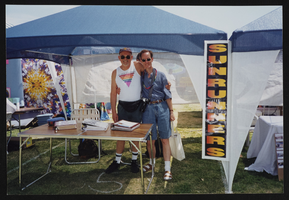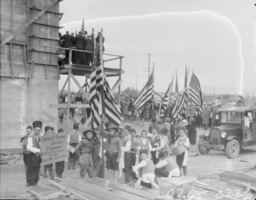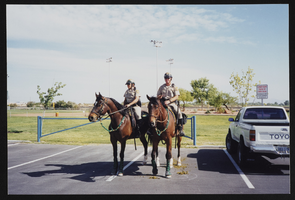Search the Special Collections and Archives Portal
Search Results
William R. Wells oral history interview
Identifier
Abstract
Oral history interview with William Wells conducted by David Emerson on May 22, 2006 for the UNLV @ 50 Oral History Project. In this interview, William Wells, the first dean of engineering at the University of Nevada, Las Vegas (UNLV), describes moving to Las Vegas, Nevada in 1986 to join UNLV. He also describes building the engineering departments, obtaining accreditation, recruiting, salaries, and faculty turnover. He then talks about diversity in the department, the successes of UNLV engineering graduates, and attracting minority groups to engineering.
Archival Collection
Helen and Thomas Taney oral history interview
Identifier
Abstract
Oral history interview with Thomas Taney and his wife, Helen Taney, conducted by Anthony Foley on October 22, 1972 for the Ralph Roske Oral History Project on Early Las Vegas. In this interview, Mr. Taney discusses moving to Las Vegas, Nevada to work in the factories and Mrs. Taney discusses moving to Las Vegas for adventure. Mrs. Taney talks about her music career and Mr. Taney talks about the importance of the railroad and the mining industry in Nevada. Lastly, Mr. Taney describes the changing water levels in Las Vegas as well as the growth of the city.
Archival Collection

Dennis McBride and an unidentified man at the Las Vegas Sunrunners booth at Gay Pride: photographic print
Date
Archival Collection
Description
Image
Ruth Moore Weaver oral history interview
Identifier
Abstract
Oral history interview with Ruth Moore Weaver conducted by her grandson, Danny Weaver, on November 22, 1986 for the Ralph Roske Oral History Project on Early Las Vegas. In this interview, Weaver begins by discussing her early life and family history. Weaver describes how Las Vegas, Nevada has developed and changed, as well her and her husband's participation in community organizations. She talks about her husband's jobs, how she prefers living in Southern Nevada compared to other areas, and segregation in the city. Weaver concludes by discussing why she prefers to live in Henderson, Nevada and the history of gambling in Nevada.
Archival Collection

Film transparency of Las Vegas High School, Las Vegas, February 22, 1930
Date
Archival Collection
Description
Image

Las Vegas Metropolitan Police Department horse patrol at Gay Pride: photographic print
Date
Archival Collection
Description
Image
Ivory H. Blue II oral history interview
Identifier
Abstract
Oral history interview with Ivory H. Blue II conducted by John Grygo on 2013 February 22 for the African Americans in Las Vegas: A Collaborative Oral History Project. This oral history documents the early life of Ivory H. Blue II in Las Vegas, Nevada while growing up in the Westside projects. He also discusses his college years in the 1990s at the University of Nevada, Las Vegas.
Archival Collection
Gloria Dea Anzalone oral history interview
Identifier
Abstract
Oral history interview with Gloria Dea Anzalone conducted by Claytee D. White on October 22, 2022 for the Boyer Early Las Vegas Oral History Project. In this interview, Gloria Dea describes her childhood in Oakland, California where she learned the art of magic from her father. Her family moved to Sacramento where Gloria Dea first performed in Breuners Department Store and by age twelve, she was working in nighclubs. Later in Hollywood, Gloria Dea danced in several films and entertained in USO shows. She performed in 1941 at the Last Frontier and the El Rancho - some of the earliest places on what was later the Las Vegas Strip. In the interview, she recalls time serving as president of both the Women's Club of Burbank, Hadassah, and the board of American Guild of Variery Artists.
Archival Collection
Judy Corbisiero oral history interviews
Identifier
Abstract
Oral history interviews with Judy Corbisiero conducted by Dennis McBride on September 05, 2003; and April 21, July 02, and December 10, 2004 for the Las Vegas Gay, Lesbian, Bisexual and Transgender Archives Oral History Project. In the interviews, Corbisiero recalls her early childhood in New York City, New York, coming out in the late 1970s, and meeting her then-partner, Janice Summers. She describes forming Summercor, Incorporated (a portmanteau of their last names) with Summers to produce women musicians, with a focus on lesbian artists, while living in New York. Corbisiero also talks about musicians she worked with, running political fundraisers during music events, and meeting her next partner, Gudrun Fonfa. She then explains moving to Las Vegas, Nevada with Fonfa in 1983 to promote women's music and culture in Las Vegas and throughout the West Coast.
Archival Collection
Harry Mortenson oral history interviews
Identifier
Abstract
Oral history interviews with Harry Mortenson conducted by Claytee D. White on April 08, 2014, April 22, 2014, and May 06, 2014 for the Boyer Early Las Vegas Oral History Project. In the first interview, Mortenson discusses his personal background, working at Los Alamos National Laboratory in New Mexico, and arriving to Nevada to work as a nuclear physicist at the Nevada Test Site. Mortenson describes his work and recalls anecdotes from his employment. He then talks about his company, Sigma Scientific, and explains the different projects where he worked as a consultant. In the second interview, Mortenson discusses the methods of transportation used to arrive to the Nevada Test Site, his involvement with different organizations, and his tenure in the Nevada State Legislature. In the final interview, Mortenson discusses the device he built to take photographs of the nuclear reactor cores at Las Alamos National Laboratory, and explains how that device worked.
Archival Collection
